|
BIOGRAPHIES
 Source: Source:
A Standard History of Lorain County, Ohio
- Vol. II -
by G. Frederick Wright
1916
<
CLICK HERE TO RETURN TO 1916 BIOGRAPHICAL
INDEX >
< CLICK HERE TO GO TO LIST
OF BIOGRAPHICAL INDEXES >
A. L. Bacon |
AARON LYNN BACON.
The untimely passing of Aaron Lynn Bacon on Sept. 3,
1912, as the result of an accident, cut short a
career of promising usefulness, and one which had
already brought him to a station of honor and
prosperity in Lorain County. He represented
one of the older families of Lorain County, and his
death was a grievous blow not only to his immediate
family but to many friends scattered far and near.
He was born in Wellington Township Oct. 4, 1881, and
was not quite thirty-one years of age when he died.
His parents of Wellington Township. George
D. Bacon, after the death of his wife moved to
Michigan and is now living at Adrian in that state.
Aaron L. Bacon grew up in the home of his
grandparents after his mother's death. They
were Sereno Dwight and Mary (Bailey) bacon.
His grandfather was born in Grafton, Vermont, in
1825, and came to Carlisle Township in Lorain County
in 1842. In May, 1851, he bought a farm in
Wellington Township, but h and his wife moved to the
village of Wellington in 1881.
The late A. L. Bacon acquired an education in
the common schools and also pursued a business
course at Oberlin. In 1903 he married for his
first wife Amanda Friend, who died in 1907.
The one child of that union, Helen, now lives
with Mrs. Bacon and is a student in school.
In 1910 Mr. Bacon married Miss Lida Miller,
a daughter of Nathan B. and Elizabeth (Dute)
Miller, a well known family of Wellington
Township, reference to whom is made on other pages.
Mrs. Bacon has one daughter, Elizabeth,
now four years of age. She is an active member
of the Baptist Church, and since the death of her
husband has made her home in Wellington.
Mr. Bacon was a republican in politics and was a
member of the Tribe of Ben Hur.
After their marriage Mr. and Mrs. Bacon moved to
his farm of 200 acres in Wellington Township, and
for a number of years he had been a successful
raiser of Holstein cattle. He had just
completed a fine modern country home by remodeling
the old two-story brick house that had stood on his
farm since 1861, and it may be said that he and
Mrs. Bacon were just equipped to live happily
and prosperously when the accident occurred by which
he lost his life. Mr. Bacon's
grandfather died in 1901 and his grandmother in
1909.
Source: A Standard History of
Lorain County, Ohio - Vol. II by G. Frederick Wright
- Publ. 1916 - Page 899 |
|
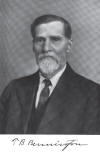
T. B. Bennington
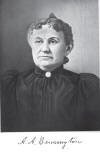
A. A. Bennington |
THOMAS B. BENNINGTON.
Source: A Standard History of Lorain County, Ohio
- Vol. II
by G. Frederick Wright - Publ. 1916 - Page 940 |
|
|
L.
S. BOISE. For nearly a
century members of the Boise family have
materially influenced the progress and development of
various localities in Northern Ohio. The chief
center of the family activities has been in Penfield
township and there L. S. Boise had constructed
out of his individual labors, persistent work and
ambition a fine farm home and is enjoying a well
deserved success and rendering an adequate service to
the community both in a business way and by his public
spirited citizenship.
He was born at Litchfield in Medina County, Ohio, Dec.
2, 1847, a son of William and Lydia (Severcool) Boise.
His paternal grandfather, Chester Boise, was born
in one of the New England sates and settled in Huron
county, Ohio, about 1821, and as a pioneer helped to
influence early development. William Boise
was born in New York State in 1814, came to Oxford in
Huron County when seven years of age, and from there
moved ot Medina County and in 1882 went to Wellington,
where he died in 1902. He was a whig and
afterwards a republican in politics and held several
local offices. He and his wife were members of the
Methodist Church. He was married to Medina County,
and his wife was born in New York State in 1820 and died
in 1901. Of their eight children seven are living:
George, an ex-soldier of the Civil war and a
retired lumberman in Northern Michigan; James,
who served a little more than a year in the Civil war,
afterwards was a druggist *
Source: A Standard History of
Lorain County, Ohio Vol. II - Publ. 1916 - Page 966 |
|
|
PATRICK HENRY BOYNTON.
Many of the distinctions and services associated with
the name Boynton in Lorain County were the
product of the career of the late Patrick Henry
Boynton, who was a member of the Elyria bar for over
forty years was one of the most accomplished and
successful attorneys of the county. He continued
active in his profession to the last day of his life,
and died suddenly while reading in his library on Apr.
28, 1911.
The Boynton family came from the State of Maine
and established its home in the wilderness of Russia
Township, Lorain County, as early as 1826.
Patrick Henry Boynton was born in Rusisa township,
Aug. 10, 1848, a son of John H. and Hulda (Heath)
Boynton. His father, John Hancock Boynton,
was long a familiar figure in business affairs of Elyria
and died in that city in July, 1899.
The Boynton family came from the State of Maine
and established its home in the wilderness of Russia
Township, Lorain County, as early as 1826.
Patrick Henry Boynton was born in Russia Township,
Aug. 10, 1848, a son of John H. and Hulda (Heath)
Boynton. His father, John Hancock Boynton,
was long a familiar figure in business affairs of
Elyria and died in that city in July, 1899.
It was in the City of Elyria that Patrick H. Boynton
spent nearly all his life, since when he was a child his
parents established their home there. As a boy he
attended the public schools, was also a student in
Oberlin College and gained part of his legal education
in the University of Michigan. For some time he
read law in the office of John C. Hale and in
1869 stood the test of examination and was admitted to
the bar. From that time forward until his death he
enjoyed a large and growing practice. He possessed
a broad and thorough knowledge of the law, and had more
than a local reputation for accuracy and painstaking
industry. He was frequently called one of the best
read lawyers in this part of Ohio. He was devoted
to his profession but his mind ranged among many other
fields and interests and probably to a degree equal to
any of his contemporaries he was truly cultured both in
mind and character. He had a broad knowledge of
general literature, and the occupation of the last hours
of his life was reading.
His life should also be remembered for his public
services. In 1888 he was elected mayor of Elyria,
and was three times re-elected, and gave the city an
administration notable for its efficiency and vigor.
On retiring from the office of mayor he was made a
waterworks trustee, became president of the board of
trustees, and worked in that capacity until the
waterworks system was placed under the control of the
board of public service in 1903. Up to his death
he served as referee in bankruptcy in the United States
Court in Lorain County. He was active in Masonry,
a member of King Solomon Lodge No. 56, Free and Accepted
Masons, and his funeral was conducted under the auspices
of the order.
An excellent estimate of what he was and what he stood
for is contained in an editorial which appeared in the
Elyria Democrat at the time of his death: "The death of
P. H. Boynton takes from the actvities of this
city's life a man who has stood high in everybody's
estimation for many years. While he was a
conservative man in many ways undemonstrative, yet he
won the respect of all who knew him by his innate sense
of fairness and honesty. His ability in his
profession was acknowledged and he was referee in many a
legal tangle. He was deliberate in his opinions
and stood uncompromisingly by his judgment. As a
man who took delight in the fine and noble things in
literature he set a high standard for the community, and
to his friends he was a constant source of inspiration
to the acquirement of those things which bring happiness
and content in this busy world."
On Dec. 30, 1875, Mr. Boynton married Miss
Mary Townshend. Mrs. Boynton died at
Elyria, Mar. 7, 1915, and there are three sons and an
adopted daughter who survive. a. J. Boynton
of Elyria; H. Percy Boynton, of Cleveland;
Sidney H., of Elyria; and Olba, now a student
in Oberlin College.
Mrs. Boynton was born in Elyria, Dec. 21, 1849,
a daughter of Dr. and Mrs. Norton S. Townshend.
The father was prominent in the affairs of the state, at
various times was a member of the Legislature, was also
a member of the Constitutional Convention in 1851-52,
and filled a position in the faculty of the Ohio State
University. He served during the Civil war as a
medical inspector, and was professor of agriculture and
was a pioneer in this field of technical education.
Mrs. Boynton for many yeas stood for the highest
things in the cultural activities of Elyria. She
attended the public schools of Elyria as a girl,
continued her education in the Lake Erie Seminary at
Painesville, and it is said that her ambition to
continue her education in the State University led that
institution to adopt plans for coeducation. For
the last several years of her life Mrs. Boynton
suffered bereavement and much personal illness through
which she set an example of rare Christian fortitude and
bravery. She was always devoted to her home, and
made it not only a place of material comfort but gave it
the atmosphere most stimulating to real culture.
Through all her years she continued to store her mind
with the results of the best thought and information and
was accomplished and learned in a number of different
fields. She was a charter member of the
Fortnightly Club, the oldest woman's club in Ohio and
the first purely literary club in the state. She
belonged to that club until her death and several times
filled the chair of president. She was also one of
the directors of the Lorain County Historical Society
and filled a similar position with the Young Women's
Christian Association, was a member of the Kozy Club,
and for many years attended and subsequently became an
active member of the First Congregational Church.
At the time of her death she was serving as
corresponding secretary of the Historical Society, and
had been identified with the Young Women's Christian
Association from its inception.
Source: A Standard History of
Lorain County, Ohio - Vol. II by G. Frederick Wright -
Publ. 1916 - Page 577 |
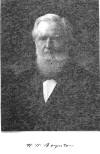
W. W. Boynton |
JUDGE WASHINGTON W.
BOYNTON. For a period longer
than the average lifetime Judge Boynton has been
a member of the Ohio bar. To the present
generation his distinguished services are sufficiently
familiar. To those who read these pages in the
future it will suffice to indicate his prominence by
saying that for years he stood second to none as a
member of the Cleveland bar, and that for five years he
read his clear, logical and forceful opinions into the
decisions of the Ohio Supreme Court. Lorain County
will always regard him as one of its foremost citizens
and one of its most distinguished native sons.
Born in Russia Township, Lorain County, Jan. 27, 1833,
Washington Wallace Boynton is the son of
General Lewis D. and Ruth (Wellman) Boynton, both of
whom were born and spent many years of their lives in
Belgrade, Maine, but in 1826 they removed to Ohio and
established themselves as pioneers in Lorain County.
Judge Boynton is directly descended from Sir
Matthew Boynton, who was created a baronet May 25,
1618, and was a member of the English parliament during
the reign of Charles I. His sympathies
became enlisted on the side of the republican cause
during the civil wars of England. His second son,
named Matthew, married Elizabeth, daughter
of Robert Stapleton, and about 1632 emigrated to
America and became identified with the New England
Colony of Boyntons.
Gen. Lewis D. Boynton was born in Maine Aug. 5,
1802, and his wife was born Feb. 22, 1806. On
coming Lorain County General Boynton acquired a
large tract of wild land in Russia Township. It is
said that much of the land now included in that township
was cleared under his superintendence and by men
employed directly by him. He was a leader in
thought and action in the early days, and at one time
served as brigadier general of the State Militia.
For the most part his years were spent in farming, and
he died in September, 1871. His wife passed away
on the old homestead in Russia Township Jan. 27, 1840.
Judge Boynton is a
product of pioneer circumstances of the old fashioned
common schools and into his character were instilled
much of the fine spirit that went with the building of
homes and the clearing up of the wilderness district.
While the hard work of a farm was his portion as a boy
he was naturally studious, and he bought a superior
judgment to every task. He attended the common
schools and select schools, stimulus save his own
ambition. When he was only a boy the people of the
community frequently remarked that "he was cut out for a
lawyer." At the age of sixteen he taught his first
term in a district school. From 1855 to 1857 he
conducted a select in Amherst Township. From 1857
to 1864 he served as county examiner of school teachers.
In the meantime he had been industriously reading law.
His director in those studies was his uncle, Elbridge
Gerry Boynton, then a leading lawyer at Elyria.
It was in 1856, fifty-nine years ago, that Judge
Boynton was admitted to the Ohio bar. However,
his work as an educator continued for a year or so
longer, and he did not begin active practice until 1858.
His first partner was L. A. Sheldon, and they
were together in practice at Elyria until 1861, when
General Sheldon went out as lieutenant colonel of
the Forty-second Ohio Regiment and subsequently gained
distinction in the Union army. Judge Boynton
was soon marked for official honor. He served as
prosecuting attorney of Lorain County from 1859 to 1864,
and in the meantime formed a partnership with John C.
Hale. Owing to ill health Judge Boynton
gave up his practice for one winter and lived in
Minneapolis during that time, until he had sufficiently
recuperated to resume his work in Lorain County.
His next partnership was with Laertes B. Smith,
and their relationship continued for several years.
It was interrupted when Governor Rutherford B. Hayes,
afterwards President, appointed Mr. Boynton
judge of the Common Pleas Court for the second
subdivision for the Fourth Judicial District. His
appointment came Feb. 9, 1869, and he retired from the
firm of Boynton & Smith and held his position on
the Common Pleas Bench from 1869 to 1877. His
district comprised the counties of Lorain, Medina and
Summit. It was his splendid work as a common pleas
judge that brought his qualifications to wider renown
when on Feb. 9, 1877, he took his seat on the Supreme
Bench of Ohio. He had been elected to that office
in October, 1876. For nearly five years he was one
of the able members of that tribunal, and every well
read lawyer in the state is familiar with some of his
clear, crisp opinions delivered from that bench.
It was ill health that compelled Judge Boynton
to retire from the Supreme Court in November, 1883, and
small compensation for his work, and he soon afterwards
located in the City of Cleveland. There he at once
took rank with the ablest attorneys of a bar second to
none in the county. His law business soon taxed
all his powers and he called to his aid his former
associate, Judge John C. Hale, who resigned from
the Common Pleas Bench to accept a partnership in
Cleveland. The law firm of Boynton & Hale
had few peers during its existence at Cleveland.
In 1888 Norton T. Horr was admitted to the firm,
which then became Boynton, Hale & Horr. In
1892 Judge Hale retired to accept a place as
judge of the Circuit Court. The firm of Boynton
& Horr handled the extensive business of the firm
until Jan. 1, 1897. Since then Judge Boynton
has given his services as a special counsel and trial
attorney in a number of the most important law cases
settled before the Ohio and Federal courts.
However, he no longer considers himself an active lawyer
and he may be well satisfied to enjoy that "otiom cum
cignitate" which the old Romans regarded as one of the
best ends of a useful life.
Judge Boynton, in
spite of his many yeas of public service, has been
essentially a lawyer. But he has been even more, a
great and a good man. He has exercised splendid
power as a speaker and pleader, and knows not only the
law but also the sciences and general literature.
At all times and under all circumstances he has been an
honest and fearless advocate of the right. His
general reading has been very extensive, and his
knowledge of the affairs of the world and of the human
heart has enabled him to meet with calm efficiency all
the exigencies of a long career.
From the time it was founded Judge Boynton has
been a loyal supporter of the republican party.
During 1865-67 he represented Lorain County in the State
Legislature. While in that body he offered the
resolution providing for the elimination of the word
"white" from the franchise qualification of the state
constitution. This resolution was defeated in the
House on the first vote, but a similar resolution was
subsequently passed by the Senate. The similar
resolution was adopted after a bitter contest by the
Lower House, and was presented to the people for final
action in the ensuing state election. It was on
this issue essentially that the democratic party in Ohio
was victorious over the republicans by more than 40,000
majority, and incidentally Allen G. Thurman went
to the United States Senate from Ohio.
Of Judge Boynton's services as a local historian
it is hardly necessary to speak here, since his direct
and indirect contribution to this field have been
acknowledged on other pages of this publication.
In the publications of the Western Reserve Historical
Society Tract No. 83 contains the historical address
prepared and delivered by Judge Boynton on July
4, 1876, the American centennial anniversary. Much
of his address pertains to local history in Lorain
County. Judge Boynton has for over forty
years been a director in the Savings Deposit Bank of
Elyria and for five years served as vice president.
He is well known all over the state, was for years a
familiar figure in the City of Cleveland, and is still a
member of the Union Club of that city.
He was married Dec. 20, 1859, at Ridgeville, Ohio, to
Miss Betsey A. Terrell. She was born at
North Ridgeville, Lorain County, a daughter of
Ichabod and Sally Terrell. At the birthplace
and home of Mrs. Boynton Judge Boynton some years
ago erected an attractive country home, and he lived
there until 1906, when he removed to Elyria and he and
his good wife have since occupied their home on
Washington Avenue in that city.
Source: A Standard History of Lorain County, Ohio -
Vol. II by G. Frederick Wright - Publ. 1916 - Page 572 |
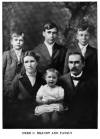
Fred C. Brandt
& Family |
FRED C. BRANDT
Source: A Standard History of
Lorain County, Ohio - Vol. II by G. Frederick Wright -
Publ. 1916 - Page 994 |
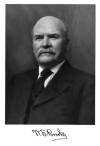
W. E. Brooks |
WALTER E. BROOKS
Source: A Standard History of
Lorain County, Ohio - Vol. II by G. Frederick Wright -
Publ. 1916 - Page 1017 |
|
|
M. G. BROWN
represents a very old family in Ohio, one which has been
identified with this state for upwards of a century.
Mr. Brown's home has been on a fine farm in
Henrietta Township for the past twenty year, and he is
well known in Lorain County.
He was born in freedom, Portage County, Ohio, Oct.
19, 1842, a son of D. A. and Minerva (Sherman) Brown.
His paternal grandfather, Daniel Brown, was born
in Massachusetts and came to Portage County, Ohio, in
1820, and spent the rest of his days there. The
maternal grandfather was Pardon Sherman, a native
of Connecticut and was also a pioneer farmer in
Portage County. D. A. Brown was born in
Massachusetts in 1812, came to Ohio at the age of eight,
finished his education in this state and after many
years spent in practical farming moved with his wife to
Oberlin, where he died in 1886. His wife was born
in Connecticut in 1815 and she also died at Oberlin in
1887. They were married in Portage County.
She was a member of the Baptist Church, while D. A.
Brown, though a member of no denomination was a god
moral Christian, a worthy citizen, was affiliated with
the whigs and afterwards with the republicans, and for a
number of years served as justice of the peace. He
was also a Knight Templar Mason. Of six children
the two now living are M. G. Brown and D. R.
Brown. The latter resides in Portage County
and has been quite successful in conducting a plant for
the manufacture of horseradish.
M. G. Brown was brought to Lorain County at the
age of four years by his parents and grew up and
received his education in Camden Township. He
lived there until he was thirty years of age, then spent
fifteen years in Huron County, and in 1896 returned to
Henrietta Township.
In 1864 Mr. Brown married Addie Kingsberry,
a native of Lorain County. She died in 1875, and
her one son, Fred Brown, is now in the ice
business at Newark New Jersey. In 1882 Mr.
Brown married Hannah Cook, daughter of C.
M. Cook, who was an early settler in Henrietta
Township and after clearing up a farm from the
wilderness spent the rest of his life there.
M. G. Brown is a member of the Masonic Order at
Wakeman in Huron County, and in politics is a democrat.
For a number of years he has devoted his time and
attention to the improvement and cultivation of his
eighty-five acre farm in Henrietta Township, and he also
owns another place of fifty acres.
Source: A Standard History of
Lorain County, Ohio - Vol. II by G. Frederick Wright -
Publ. 1916 - Page 1034 |
|
|
PHILIP BRUNK.
The career of Philip Brunk well illustrates
what may be accomplished by the following out of an
honorable purpose with firm determination and
self-reliance. His only resource when he began
active life was natural ability, but he possessed
also will power and was able to make the most of his
opportunities. He learned early the value of
self-help and the virtues of industry, frugality and
fidelity, set himself a high ideal, and in a
practical common-sense way has directed his every
effort toward its attainment, with the result that
now, still in the strength and vigor of manhood, he
has achieved a most gratifying success.
Philip Brunk, secretary and treasurer of the
Brunk Machine and Forging Company, Incorporated,
of Lorain, Ohio, was born in Germany, Dec. 22, 1858,
and is a son of Philip and Dorothy
Brunk. He was educated in the public
schools of his native land and as a youth learned
the blacksmith's and still later the machinist's
trades. He found his opportunities limited in
the Fatherland, and as a young man came to the
decision that America offered a more advantageous
field for the display of his abilities.
Accordingly, in 1884, he emigrated to this country,
settling at Lorain, where he secured employment in
the shops of the C. L. & W. Railroad, which is now a
part of the Baltimore & Ohio System. After
seven years with this road, during which he gained
promotion through industry and faithful performance
of duty, and carefully saved his earnings, he
established himself in business as the proprietor of
a machine shop. From small beginnings, this
venture was developed into an industry of
pretentious size, and in 1903 was incorporated under
style of the Brunk Machine and Forging
Company, with a capital of $35,000, its present
officials being: W. M. Dabney,
president; C. Krentz, vice president; and
Philip Brunk, secretary and treasurer. The
company employs twenty skilled mechanics, and its
products meet with a ready sale in the large markets
of the state shipping to all points. The plant
consists of two buildings, both two stories in
height and of modern construction and equipment, a
machine shop 50 by 100 feet, and a garage, 132 by 30
feet, the latter erected in 1915. The life of
this firm has been typical of the life of the city
itself, for its foundation and resources were
principally the sound judgment and accurate
foresight of its founders, and as the city stands
prominent for its rapid development, so of the firm
for its founders builded better than they
knew, and from a small beginning the amount of
business transacted has grown to large proportions.
Mr. Brunk was married in 1884, shortly after
coming to Lorain, to Miss Emma Heyer, and to
this union there have been born three children,
namely: Lena, who is the wife of Arthur
Eppley, a foreman in the plant of the National
Tube Company, of Lorain; Edna, who is now
Mrs. Edward Merthe, wife of a machinist of this
city; and Laura, who is the wife of
Gilbert Irish, connected with the
Baltimore & Ohio Railroad at Lorain.
Mr. Brunk is a popular member of the local
lodges of the Knights of Pythias, the Benevolent and
Protective Order of Elks and the Knights of the
Maccabees. He is a member of the Immanuel
Evangelical Church. In politics his work for
his party's interests is as a citizen and a voter
rather than in active participation in political
affairs. In Mr. Brunk's life are found
all the habits, methods and qualifications which
have rapidly brought the American nation to the
forefront, as compared with the older countries, in
all that pertains to the growth prosperity and
development of the national spirit of life.
Source: A Standard History of Lorain County, Ohio -
Vol. II by G. Frederick Wright - Publ. 1916 - Page 714 |
NOTES: |